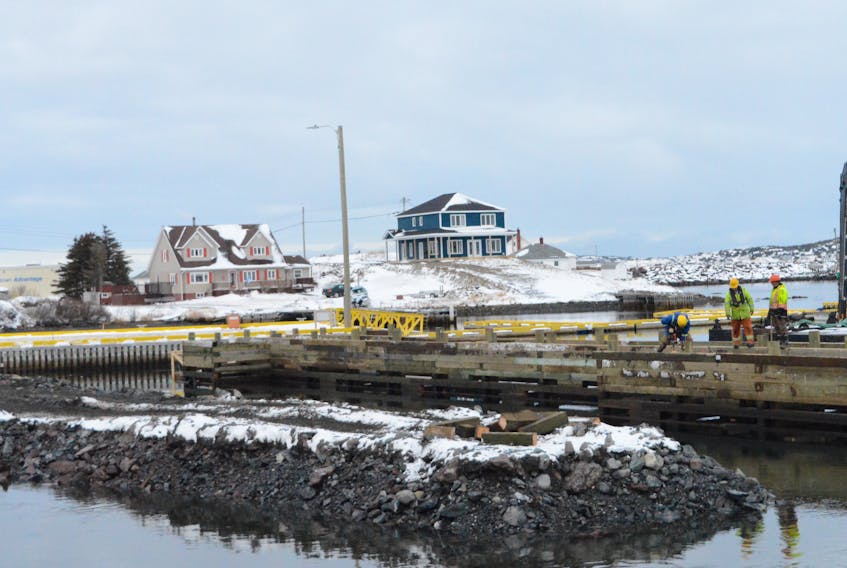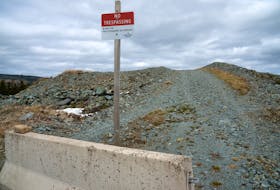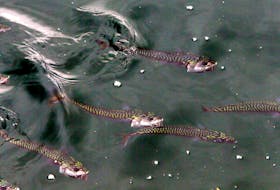A new search and rescue operation is coming to the northeast coast of Newfoundland and Labrador, expected to be completed for the summer of 2019.
Located in Twillingate, construction is well underway for the wharf and floating docks that will house the Canadian Coast Guard Search and Rescue (SAR) lifeboat coming to the area.
Harvey Vardy, superintendent for the Maritime Coast Guard SAR in the Atlantic Region, says this location proved favorably because of the strategic location of Twillingate’s harbour and the surrounding infrastructure. A station for the lifeboat crew will be located across the street from the wharf facility, currently being built at the town’s former RCMP office.
Up until this facility goes into operation, Vardy says the coast guard’s offshore SAR patrol vessels respond to search and rescue calls from this area. Now, having this facility directly in the central region the response times and search and rescue resources will considerably improve.
“Prior to this build, these offshore platforms are what we would have called upon,” said Vardy. “Now, we will have a new primary star vessel located in Twillingate that will be available to us throughout the operation season.
“It’s a huge increase in search and rescue capacity for us.”
Twillingate Mayor Grant White says while this new SAR operation brings increased infrastructure and employment to the area, the most important advantage is the new resources and capabilities it will bring to the entire central and northeast region.

“More important than all of that is this is going to bring trained and experienced rescue personnel to deal with marine incidents,” White said. “That’s going to give people peace of mind. The response times are going to be less and we’ll have more resources on the coastline.
“It’s not just for our town, it’s an extreme benefit for the entire region.”
According to Vardy, for the past two years the coast guard has been studying harbour characteristics such as water depth, ice conditions, wharf facilities and community infrastructure to determine the location for a new SAR operation and lifeboat station along the northeast coast.
The process began with the announcement of $1.5 billion in federal funds under the Ocean Protection Plan, announced on Nov. 7, 2016. The plan is in place to improve marine safety, responsible shipping, marine environment and create opportunities for Indigenous and coastal communities.
When in place, the station will employ two four-member crews. Vardy says this is the standard for these SAR lifeboat operations.
“Right now we have two lifeboat stations on the west coast and two on the south coast. We didn’t have lifeboats on the northeast coast before this,” he said. “It will be great for increasing the capacity we didn’t have on the east coast and concentrating on the near-shore search and rescue incidents.”
The Central Voice acquired the number of search and rescue cases in each area of the province for the past five years, provided via the Canadian Coast Guard Atlantic and the Department of Fisheries and Oceans (DFO).
Area 33, along the east coast from the Eastport area down to the Avalon, had the overwhelming number of search and area cases from 2013-17 at 796. But area 32, from the eastern side of the Northern Peninsula down to the Wesleyville area of central Newfoundland, had the second highest volume of cases at 419. The new lifeboat station in Twillingate will be located near the centre of this area.
In an emailed response from DFO, the severity of these cases can range from false alarms to a large-scale response involving the deployment of SAR resources on the sea and in the air.

Number of search and rescue cases in Newfoundland and Labrador, 2013-17
The Canadian Coast Guard divides the Search and Rescue areas of the province by SAR Area 31, from the west coast of the Northern Peninsula down to Channel Port aux Basques, SAR Area 32, being the northeast coast from the eastern side of the Northern Peninsula down to the Wesleyville area, SAR Area 33 for Eastport Peninsula and down through the Avalon, and SAR Area 34 for the St. Shotts shore of the Avalon to Channel Port aux Basques.
Northeast Coast (SAR Area 32):
2013 = 82
2014 = 91
2015 = 93
2016 = 78
2017 = 75
East Coast (SAR Area 33):
2013 = 161
2014 = 166
2015 = 155
2016 = 142
2017 = 172
South Coast (SAR Area 34)
2013 = 84
2014 = 72
2015 = 71
2016 = 73
2017 = 61
West Coast (SAR Area 31)
2013 = 42
2014 = 40
2015 = 47
2016 = 40
2017 = 56
Numbers acquired via the Canadian Coast Guard Atlantic and the Department of Fisheries and Oceans.









